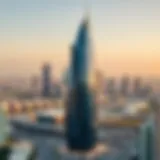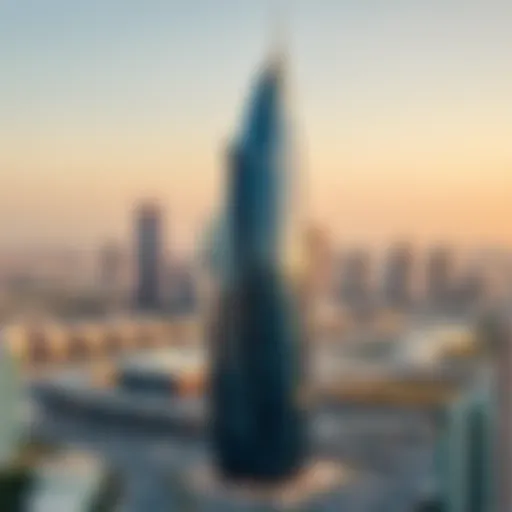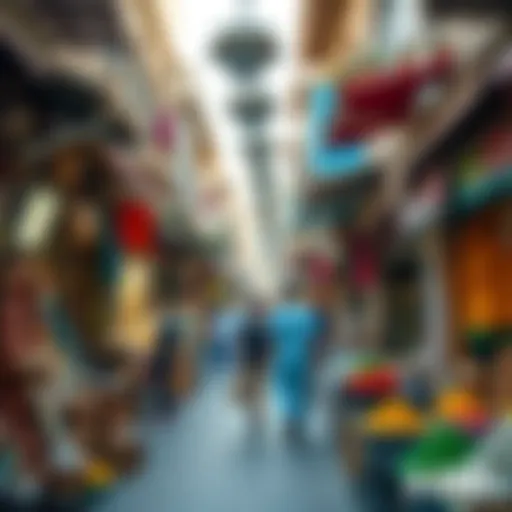Exploring Souk Deira: Cultural and Economic Hub of Dubai
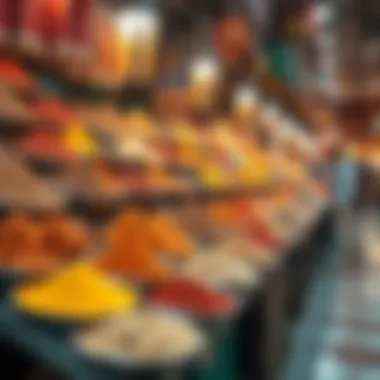
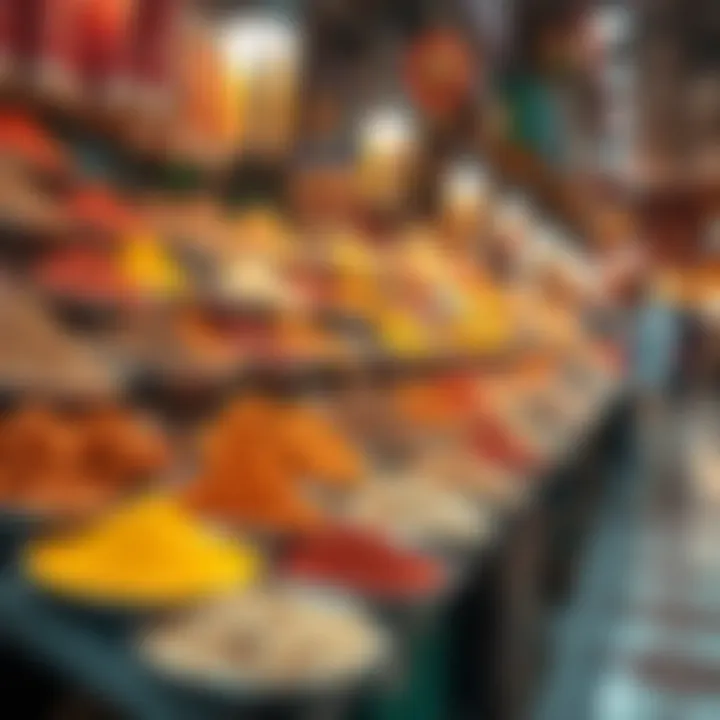
Intro
Nestled in the heart of Dubai, the Souk Deira is far more than just a bustling marketplace. It serves as an essential thread in the fabric of the city's cultural and economic landscape. With its winding alleys and dazzling displays of goods, walking through the souk feels like a journey through time, a mix of old-world charm fused with the lively spirit of modernity.
The historical roots of Souk Deira run deep, dating back centuries when it was primarily a trading hub for spices, textiles, and gold. Today, this iconic marketplace plays a pivotal role in the local economy while concurrently catering to the tastes and preferences of both residents and tourists. Travelers are not just purchasing items; they are engaging with the rich tapestry of culture that the souk embodies.
This article seeks to provide an insightful look into various aspects of the Souk Deira, from its significant historical footprint to its architectural allure, all the while exploring its economic relevance in contemporary Dubai.
We'll examine the types of goods you'll come across in the souk, share the experiences visitors often encounter, and underscore its integral role in preserving cultural heritage while adjusting to the evolving market demands.
Through this exploration, readers can gain a comprehensive understanding of how Souk Deira is not only a place for shopping but also a vibrant cultural venue that continues to thrive and evolve.
Historical Context of Souk Deira
The journey through Dubai's vibrant cultural fabric begins at the Souk Deira, an essential landmark that embodies the essence of the city's rich history and bustling economy. Understanding the historical context of Souk Deira is vital for those looking to appreciate its significance, both in past and present times. This marketplace has long been a vital junction where trade and culture meet, showcasing how traditional practices have influenced modern commerce.
Origins and Development
The origins of Souk Deira can be traced back to a time when Dubai was a modest fishing and pearling village. Its strategic position along trade routes made it a natural hub for merchants seeking to connect with distant lands. The souk emerged as a bustling marketplace in the late 19th and early 20th centuries, attracting traders from various backgrounds, including Persians, Indians, and local Arabs.
Initially, the souk catered to the basic needs of the local population. As the economy began to shift with increased trade activities, the types of goods available started to diversify. Merchants offered everything from textiles to spices, and over time, Souk Deira grew in stature. The development of infrastructure projects in the 1970s, such as the expansion of the creek, furthered its accessibility, allowing it to flourish into a central economic artery for Dubai.
Traditional Trade Practices
At the heart of Souk Deira’s appeal lies the traditional trading practices that have defined its operations for generations. For many traders, it's not just about profit but maintaining a legacy of trust and community. These practices include haggling—a skill that both buyers and sellers have honed over time. Bargaining here is not merely about price but an integral part of the shopping experience.
In the past, the souk was dominated by raw commodities, particularly spices and textiles. Traders would source these items from distant lands, giving rise to a unique blend of cultures and flavors within the marketplace. Local fishermen brought in fresh catches, while artisans displayed handcrafted goods, reflecting the craftsmanship passed down through generations.
Today, while the methods may have adapted to modern needs, the spirit of traditional trade remains alive. Vendors still engage in personal interactions with customers, often sharing stories about the provenance of their goods. This connection fosters a sense of community, drawing in locals and visitors alike, eager to experience an authentic slice of Dubai’s trading heritage.
"In the bustling lanes of Souk Deira, every stall tells a story—a tale of barter, trust, and the unyielding spirit of trade that has endured through the sands of time."
The historical significance of Souk Deira extends beyond mere commerce. It's an enduring testament to how cultures and economies can intertwine, creating a tapestry rich in tradition yet responsive to the dynamism of modern-day Dubai. As we peel back the layers of this iconic souk, we uncover not just historical facts, but a living narrative that continues to evolve.
Architectural Features of Souk Deira
Understanding the architectural features of Souk Deira is essential not only for its aesthetic appeal but also for its role in enhancing the cultural vibrancy and economic activity of the area. The design elements and construction methods provide insight into the traditional techniques that have stood the test of time, showcasing an approach that balances functionality with artistry.
Design Elements
The layout of Souk Deira reflects a deeply rooted historical context, characterized by winding pathways and open courtyards that invite exploration. Unlike modern retail settings where space is often dictated by flow and efficiency, the design here promotes a sense of discovery.
- Arched Doorways: These elegant arches are not merely decorative but designed to provide shade, essential in the searing heat of Dubai’s climate.
- Mashrabiya Screens: This traditional wooden lattice work adds a touch of privacy while allowing airflow. Vendors can keep their goods protected from the elements, all while maintaining visibility for potential customers.
- Colorful Signage: Brightly painted signs hang above the shopfronts, drawing visitors in. The eclectic mix of hues adds an artistic flair that reflects the diversity of cultures present in the souk.
These features encapsulate the essence of the souk, delivering a sensory experience that modern shopping venues often lack. As visitors stroll through, they absorb the vibrancy and warmth that these well-thought-out design elements convey, making each visit unique.
Materials and Construction Methods
The choice of materials used in constructing Souk Deira speaks volumes about the local climate and traditional craftsmanship.
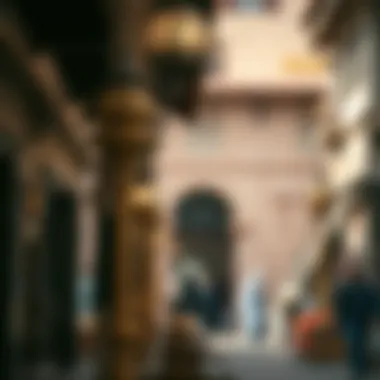
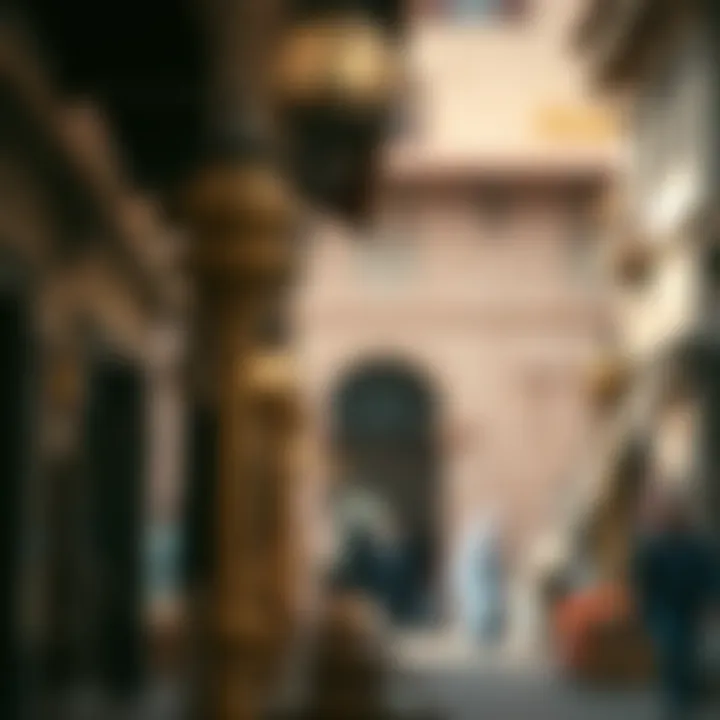
- Local Stone and Wood: Many parts of the souk are built from materials that have been sourced locally, showcasing the skills of artisans who have passed down knowledge through generations.
- Low Ceilings: The ceilings in many shops are intentionally low to create a more intimate shopping experience while keeping the space cool, reducing reliance on electricity for air conditioning.
- Mud and Palm Fronds: Early shops were often constructed using mud bricks and palm fronds, providing natural insulation and comfort. This highlights a resourceful way of building that has now transitioned, yet still, whispers of its roots remain.
These methods intertwine with cultural practices, ensuring that the architecture of Souk Deira encapsulates the spirit of Dubai's rich heritage while adapting to contemporary needs.
"Architecture is the art of how to waste space." — Philip Johnson
The architectural features of Souk Deira are more than just visual elements; they embody the economic and cultural fabric of the community, showcasing a synergy between past traditions and present-day demands. This unique framework creates a market space that facilitates vibrant interactions, making it a cherished landmark in Dubai.
Economic Significance of Souk Deira
The Souk Deira stands as a vibrant microcosm of Dubai’s economic landscape. Its significance cannot be overstated; it is an emblem of trade, culture, and economic interaction that has thrived for generations. In examining the economic importance of Souk Deira, one must delve into the dynamics of its marketplace and the substantial role it plays in both local and broader economic contexts.
Current Market Dynamics
As the city of Dubai burgeons with modern attributes, the Souk Deira remains a captivating anchor to its past. The current market dynamics within this traditional marketplace are fascinating to explore. Here, one can find an array of goods, from intricate textiles to aromatic spices, that compete with newer retail options yet maintain a unique charm.
- Competitive Pricing: Many vendors leverage the bustling foot traffic to offer goods at lower prices compared to modern malls. This dynamic imports a sense of affordability that is often absent in high-end shopping centers.
- Cultural Interaction: The Souk attracts not only locals but a multitude of tourists eager to immerse themselves in an authentic shopping experience. This constant mingling of cultures fosters an environment ripe for trade and exchange of ideas.
- Shifts in Consumer Behavior: With e-commerce on the rise, traditional shops have adapted by enhancing their customer experiences and diversifying product offerings.
Furthermore, the use of social media platforms like Instagram and Facebook has helped local merchants showcase their products, reeling in tech-savvy consumers who may prefer shopping in a digital space but can be tempted by the tangible allure of in-person experiences.
Role in Local Economy
In the broader spectrum, the Souk Deira plays a pivotal role in bolstering the local economy, facilitating not just commerce but also providing employment opportunities and preserving cultural heritage.
- Employment Opportunities: The marketplace employs thousands, drawing individuals from various backgrounds, all contributing to Dubai’s labor force. From shopkeepers to artisans, each individual plays a part in the dynamic fabric of this economic hub.
- Cultural Preservation: The Souk is not just about trade; it is a repository of traditions and skills. The craft of goldsmithing, unique textile patterns, and specific spice blends are passed down through generations, securing livelihoods while safeguarding cultural identity.
- Tourism and Economic Ripple Effects: Tourists flock to Souk Deira not merely to purchase goods but to experience the essence of Dubai’s heritage. This influx generates additional economic benefits for nearby restaurants, hotels, and transportation services, thus amplifying its economic significance.
In essence, Souk Deira transcends the notion of outdated commerce; it is a thriving testament to resilience. As economic patterns shift, this marketplace is likely to innovate while preserving its heart, serving as a poignant reminder that the past still holds value in a rapidly evolving world. Ultimately, understanding the economic significance of Souk Deira sheds light on broader themes of cultural endurance and community cohesion, crucial for stakeholders ranging from investors to local entrepreneurs.
Goods and Services at Souk Deira
The Souk Deira is not just a marketplace; it serves as a living tapestry of Dubai's thriving culture and economic vibrancy. For investors and potential business owners, understanding the goods and services offered within its storied lanes is paramount. Each stall, each merchant, reflects a unique aspect of local life, providing a rich catalog of products that draw both residents and tourists alike. The interplay between tradition and commerce here can be a case study in the sustainability of local economies.
Textiles and Clothing
In the dimly lit alleys of Souk Deira, the scent of fabric mingles with the chatter of customers. Textiles are a cornerstone of this marketplace. The market features an abundance of fabrics ranging from cottons, silks, to rich brocades that provide a glimpse into both local and international influences. Clothing options often reflect regional styles, with tailors offering customizable pieces that appeal to individual tastes.
Visitors and locals often find themselves bargaining for finely crafted garments and unique accessories. With patterns inspired by Islamic art and modern designs, these pieces not only serve function but also convey a sense of identity. Factors like fabric quality, craftsmanship, and local creativity enhance the textiles' value, making them alluring to those looking to invest in authentic attire.
Spices and Culinary Delights
Turning the corner, the stalls overflowing with spices present a feast for the senses. The colors of saffron, turmeric, and cumin create an inviting atmosphere that speaks volumes about Dubai's rich culinary heritage. Souk Deira is known for its extensive spice offerings, which are more than mere ingredients; they are gateways to cultural experiences.
Visitors can purchase fresh herbs alongside indigenous spices that reflect the flavors of the region. Beyond spices, there are also numerous stalls dedicated to culinary delights — think local sweets and ready-to-eat dishes that captivate the palate. As a space of culinary discovery, the market encourages both seasoned cooks and casual visitors to engage deeply with the local food culture. From a business perspective, understanding these offerings is vital. Inventory that reflects a careful curation of spices can drive customer engagement and foster loyalty.
Gold and Jewelry Market
No exploration of Souk Deira would be complete without diving into its famed gold and jewelry market. Here, glittering displays of gold jewelry entice shoppers, showcasing everything from intricate rings to sizable necklaces. The allure of gold goes beyond aesthetics; it symbolizes wealth and is often seen as a safe investment, particularly in the Middle East.
Merchants often have an encyclopedic knowledge of their wares, able to recount the history of the gold trade in the region and the craftsmanship behind each piece. What's more, competition keeps prices reasonable, providing consumers with both high-quality options and the chance to negotiate. For discerning investors, familiarizing oneself with these trends may yield insights into consumer behavior and market demands.
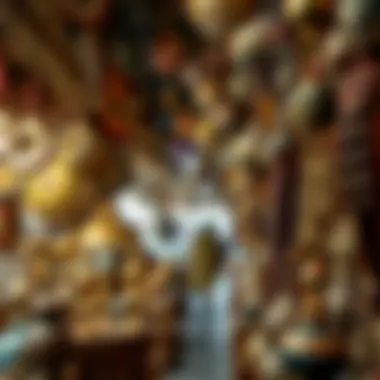
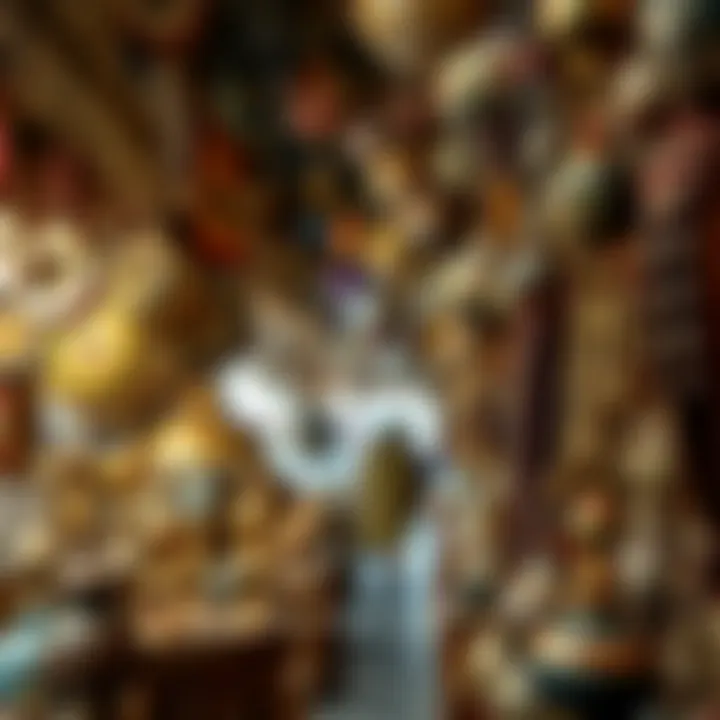
"At Souk Deira, every visit is a chance to discover and taste the pulse of a culture that blends history with modernity."
Cultural Impact of Souk Deira
The Souk Deira stands not just as a marketplace, but as a vital thread woven into the fabric of Dubai’s social and cultural identity. Its significance extends far beyond commerce; it is a place where traditions are honored and community ties strengthened. This section examines the essential elements of the cultural impact that Souk Deira has had on both locals and visitors alike.
Preservation of Traditions
In an age where fast fashion dominates the retail world, Souk Deira reminds us of the importance of traditions. Here, you’ll find craftsmen, artisans, and traders who carry forth practices handed down through generations. For instance, the art of weaving fabrics or crafting intricate jewelry is not just about selling, but about community storytelling—each piece holds history and heritage.
“Souk Deira serves as a living museum, where you can see and feel the pulse of Dubai’s traditions.”
This preservation is vital as it not only showcases the artistic skills of local artisans but also attracts tourists who seek an authentic experience. Workshops often take place on-site, allowing visitors to participate in dyeing textiles or creating handicrafts. Such interactions provide deeper insights into local customs, promoting a sense of belonging and appreciation for Dubai’s cultural roots.
Community Engagement and Events
Souk Deira thrives on its vibrant community engagement. Numerous events are organized throughout the year that bring together residents and visitors, fostering a spirit of camaraderie. For example, festivals featuring traditional music, dance, and food attract diverse crowds.
The souk frequently hosts seasonal celebrations such as Ramadan nights or UAE National Day events, turning the market into a mosaic of cultural activities. These gatherings not only boost foot traffic but also rejuvenate interest in the local culture. Community workshops and market days engage younger generations, teaching them the value of their heritage while inviting new ideas into traditional practices.
Furthermore, as tourists wander through the winding pathways lined with colorful stalls, it becomes clear that Souk Deira serves as a melting pot. The blending of cultures creates opportunities for meaningful exchanges, making it a place where stories are shared, and friendships bloom.
Ultimately, the cultural impact of Souk Deira is profound. It nurtures an understanding of Dubai’s historical narrative and keeps these traditions alive in the ever-evolving landscape. With each visit, both locals and tourists contribute to the preservation and evolution of this vibrant cultural heritage.
Visitor Experience at Souk Deira
The Souk Deira presents an eclectic blend of sights, sounds, and flavors that create a rich tapestry for visitors. It's important for those who seek understanding beyond the surface of mere commercialism. The souk serves as a microcosm of Dubai itself—a traditional marketplace that stands as a vibrant witness to the city's swift evolution whilst maintaining its cultural essence. Engaging with the souk not only allows visitors to shop but also offers an immersive experience of authentic Emirati culture.
Navigating the Souk
Wandering through the narrow alleyways of Souk Deira can feel like discovering a hidden world. Visitors might initially feel overwhelmed, but that’s just part of its charm. The best way to navigate is to follow the scent of spices or the glint of gold. Each corner offers a surprise, whether it's the intricate patterns of textiles or the bustling atmosphere where haggling is not just accepted; it’s expected.
- Plan Your Route: Knowing where you want to go can save valuable time. The spice market is a must, and so is the gold souk which dazzles with its luxury.
- Use Landmarks: Familiarize yourself with key spots, like the entrance to the souk or the notable shops with unique offerings, to help in your navigation.
- Engagement with Vendors: The shop owners are usually quite friendly and can offer insights into their craft. Strike up conversations about the goods, their origins, and even some history about the souk itself.
While getting lost can be a part of the charm, having a mental map can enhance the experience.
Culinary Experiences
Food stalls and little eateries contribute significantly to the allure of Souk Deira. The culinary scene encapsulates both traditional and modern aspects of Emirati cuisine, maintaining a fragrant allure that beckons tourists. Aromas waft through the air, inviting visitors to indulge in local snacks and beverages. Here’s what to expect:
- Savor Local Delights: Sample dishes like shawarma and falafel from trusted vendors. Don’t miss the chance to try kunafa, a sweet delicacy that perfectly embodies the confluence of local flavors.
- Drinks to Beat the Heat: Cooling drinks, such as mint lemonade or fresh fruit juices, are excellent choices that refresh during warm days. They’re often artfully made right in front of you.
- Cultural Connections: Dining here isn’t just about food—it’s a communal experience where narratives about family recipes and cultural heritage are shared, deepening the appreciation of the meals.
Reflecting on the culinary journey within the souk fosters a deeper connection to the culture and community it serves.
Shopping and Bargaining Tips
Shopping at Souk Deira is a unique experience, notably characterized by the art of bargaining. Those unfamiliar with how to handle negotiations may find it quite daunting, but understanding the nuances can enhance the experience. Here are some helpful tips:
- Start Low, Aim High: When you ask for a price, begin with an amount significantly lower than what you are willing to pay. This offers room for negotiation while keeping the dialogue lively.
- Know When to Walk Away: If an initial price doesn’t suit your budget, showing disinterest can sometimes lead to surprising discounts, as vendors strive to keep your attention.
- Observe Market Prices: Before you jump into negotiations, it’s wise to check prices across different stalls for similar products, giving yourself leverage in talks.
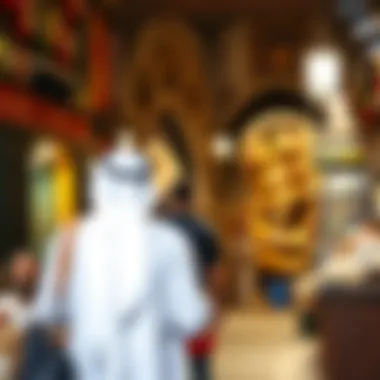
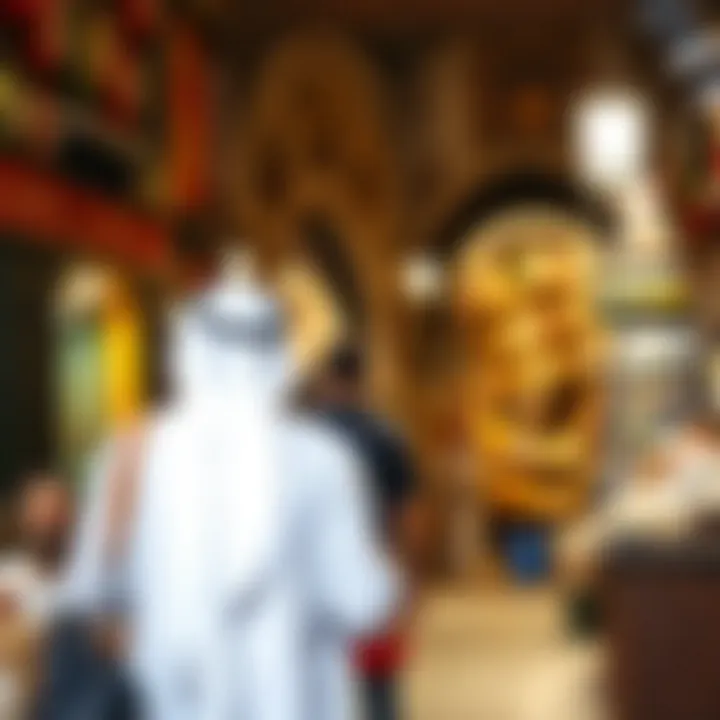
End
“In the heart of a city that is ever-growing, Souk Deira is a reminder of the past that still thrives alongside the present.”
For more information on traditional markets, you can visit Wikipedia.
Challenges Facing Souk Deira
The market landscape in Dubai has seen a considerable shift, and the challenges facing Souk Deira underline significant tensions between tradition and modernization. Addressing these challenges not only aids in the preservation of cultural heritage but also emphasizes the economic vitality of this historic marketplace. Souk Deira, as an iconic symbol of Dubai’s rich past, now finds itself navigating the intricate realities of a rapidly evolving market. This section delves into two core challenges: competition from modern malls and the impact of economic changes.
Competition from Modern Malls
At the heart of the struggle lies the fierce competition from modern shopping malls, such as Dubai Mall and Mall of the Emirates. These commercial giants offer a broad array of high-end brands, entertainment options, and air-conditioned comfort, pulling crowds with their glitzy facades and consumer-friendly conveniences.
- Convenience: For many shoppers, the ease of parking, cleanliness, and luxurious atmosphere of these malls present an attractive alternative.
- Price Sensitivity: Shoppers often perceive malls as providing better deals due to extensive sales and discounts, which can undermine Souk Deira's unique bargaining culture.
- Cultural Disconnect: The experience offered in shopping malls can create a gap for younger generations who might find the allure of branded goods more compelling than exploring traditional markets.
Despite these pressures, Souk Deira has its own unique charm and cultural significance which cannot be replaced. The atmosphere of friendly haggling, the rich aromas of spices, and the vibrant colors of textiles can't be replicated elsewhere. However, the souk needs to innovate and perhaps offer more attractions or experiences to draw in the crowd.
Impact of Economic Changes
Economic fluctuations have a direct bearing on Souk Deira’s viability. Global events like the COVID-19 pandemic shook not only local economies but also disrupted traditional trade practices. Additionally, inflationary pressures have led to increased costs for both merchants and consumers. This situation creates a stark landscape for Souk Deira, characterized by several key stresses:
- Decreased Foot Traffic: With rising prices, consumers become more cautious in their spending, leading to a decline in foot traffic in the souk. It is a struggle for merchants to maintain their clientele in tough economic times.
- Financial Strain on Traders: Many small tradespeople who have operated in the souk for generations are feeling the pinch as they try to balance expenses while retaining their loyal customers.
- Adaptation Required: The souk’s ability to adapt quickly to changing economic conditions—whether through digital platforms or different trading practices—could determine its survival.
"The market must evolve or risk becoming a relic of the past, much like the remnants of old trade routes that once thrived in the region."
Future of Souk Deira
The Souk Deira stands at a crossroads where rich tradition meets modernity. What’s ahead for this beloved marketplace is crucial for those who value cultural heritage and economic vitality. As Dubai evolves into a global hub, understanding the future of Souk Deira could greatly influence investors, homeowners, expatriates, agents, and developers. The dynamics within the arena of urban development beckon intriguing possibilities and challenges that could reshape the souk’s identity.
Potential for Development
The ongoing developments in Dubai present an enticing opportunity for the Souk Deira to enhance its offerings and appeal. The government’s focus on promoting tourism through various initiatives could be a double-edged sword. With plans for smart city expansions and infrastructural improvements, the souk can grow from a market into a multi-faceted cultural center.
- Revitalization Projects: Investments can be directed towards upgrading current facilities to better serve visitors and traders alike. Improving accessibility, incorporating modern amenities, and maintaining aesthetic integrity will play a big role.
- Cultural Programming: By organizing events such as art fairs, culinary festivals, and traditional craft exhibitions, Souk Deira can attract a wider audience. Adding more cultural dimensions can solidify its role in Dubai's social fabric.
- Diverse Offerings: Expanding the variety of goods sold, from local artisans to contemporary fashion brands, could draw more foot traffic. Including businesses that resonate with younger generations will be essential to keeping the souk relevant.
Sustainability Initiatives
As the global conversation shifts toward sustainability, Souk Deira could lead by example by embracing eco-friendly practices. Given that sustainability is not merely a trend but a necessity, incorporating such initiatives will ensure its longevity and relevance in the market.
- Sourcing Locally: Encouraging vendors to source materials and products locally could reduce carbon footprints and support the local economy.
- Waste Management Practices: Implementing a robust waste management system can show commitment to environmental stewardship. Recycling and reducing plastic use can set precedents for future markets.
- Energy Efficiency: Upgrading facilities with energy-efficient lighting and climate control systems not only cuts costs but also promotes a sustainable image.
Sustaining a tradition like the Souk Deira through environmentally conscious initiatives could bridge the gap between cultural heritage and modern expectations, showcasing that the old and new can coexist.
Culmination: The Significance of Souk Deira Today
Souk Deira stands as a historic emblem of Dubai’s vibrant past, perfectly balancing its dual roles of cultural and economic significance in today’s rapidly evolving landscape. It is more than just a marketplace; it is a living museum, where the essence of traditional Emirati commerce, lifestyle, and heritage still thrive amidst the encroaching modernization surrounding it.
Cultural Legacy and Economic Resilience
Souk Deira’s cultural legacy is deeply intertwined with the identity of Dubai itself. The alleys of the souk tell stories, echoing the footsteps of traders who have exchanged goods and tales for centuries. The textiles, spices, and jewelry available serve as tangible representations of an age-old tradition that transcends generations. Visitors and residents alike engage with a cultural fabric that is rich and diverse, reflecting the emirate's multicultural community.
The economic resilience of Souk Deira cannot be understated. In an era when modern malls and online shopping dominate, the souk has maintained its draw through authenticity and a personal touch. Many shop owners are multi-generational families who nurture relationships with customers, often remembering their names and preferences. This builds loyalty that the sterile environment of a mall cannot replicate.
It’s essential to recognize that Souk Deira is not just a relic of the past; it is adapting with the times. E-commerce may be sprouting new branches, but there’s still an air of exclusivity around items found in the souk, things you just can’t get from an online retailer. For investors and business owners, this means opportunity – tapping into a market that values both heritage and novelty. Furthermore, with the rise of tourism, the souk is set to flourish even more, attracting visitors looking for genuine experiences and local connections.
"Souk Deira is a treasure trove of culture, where every corner bends with history, and every interaction weaves a tapestry of the present and future."
